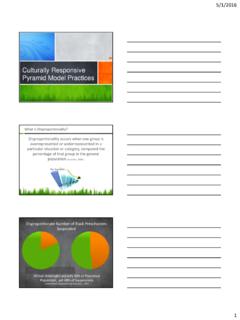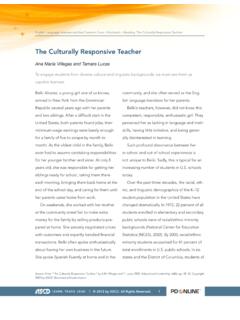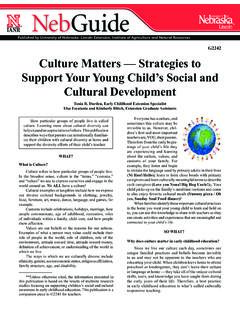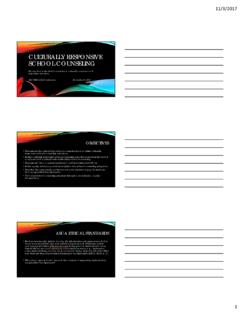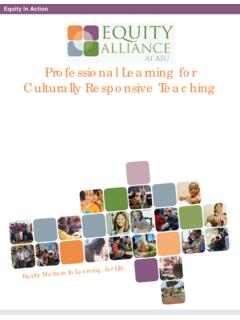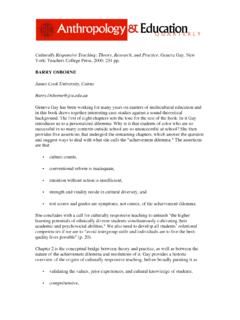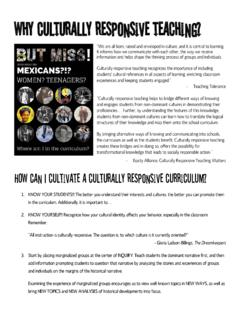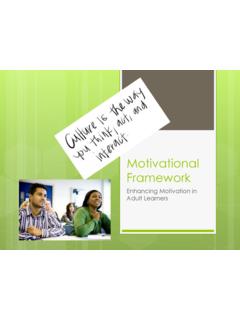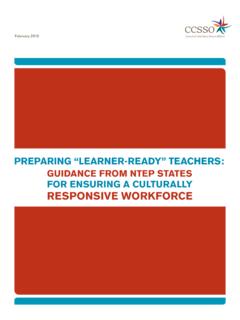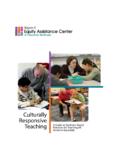Transcription of Culture as the Lens Through Which Children Learn Best ...
1 Culture as the lens Through Which Children Learn best : implications for Policies to Improve teaching Aisha Ray, Erikson Institute Chicago, IL BUILD & CEELO: Learning Table on State Policy to Improve teaching and Children s Learning Chicago, Illinois April 28-29, 2015 Culture As the lens Through Which Children Learn best 1 No other intervention can make the difference that a knowledgeable skillful teacher can make in the learning process (Darling-Hammond, 1997) Children from culturally diverse communities, poor Children , and Children from marginalized racial groups have better educational outcomes when teachers have knowledge and practice skills that support home Culture and language (Au & Mason, 1981, 1983; Dee, 2004; Knapp & Associates, 1995; Pewewardy, 1994).
2 2 Culture As the lens Through Which Children Learn best Problems 1 - PD Policies and Problem 4 - Ensuring Racially, culturally and Linguistically Competent teaching 1. Culture matters in teaching and learning 2. culturally responsive teaching can contribute to optimal child outcomes 3. culturally responsive teachers need to be nurtured Through strengthening systems that support teaching and learning and intentional professional development implications for building state systems 3 Culture As the lens Through Which Children Learn best Children in the United States A very complex group that includes.
3 Children from cultural and racial/ethnic groups African American, Asian American, Alaskan Native, Latino, Native American, Pacific Islanders, and Children of immigrants Children whose first languages and dialects Children in poverty Children from all groups including Children of color, immigrant Children , and White Children Children with diverse abilities Children from the world s cultures Children in these categories are more likely to have poorer early developmental and educational outcomes than middle-class Children 4 Culture As the lens Through Which Children Learn best Theory.
4 Research & consensus documents in the early childhood field occurs in the context of Culture s cultural and language identity are essential to their optimal development s home Culture and language should be used as platforms for teaching and learning have a right to the knowledge and skills of power ( , literacy, school English ) and a right to their cultural and linguistic traditions 5 Culture As the lens Through Which Children Learn best The challenges in early care and education equity Creating equitable, high quality early care and education systems that have sufficient policies, programs and capacities in place to support and sustain optimal developmental and educational outcomes for all Children , including the most vulnerable.
5 Creating a workforce at all levels that is able to provide equitable, high quality, culturally responsive , intellectually rigorous, and emotionally supportive care and education for Children , including the most vulnerable. 6 Culture As the lens Through Which Children Learn best culturally responsive teachers It appears that insufficient numbers of teachers have the skills to be effective educators for all Children . Research suggests that teachers may feel unprepared to teach Children who they perceive to be different (class, race, language, ability, and so forth).
6 (Sleeter; Ray and Bowman; Banks; Lee) Ray and Fleming found that higher education faculty in 2- and 4- year early childhood teacher preparation programs report that less than 25% of their graduates were culturally competent. State systems are not sufficiently funded, integrated and coordinated to provide the context and supports for the development of a culturally responsive workforce. 7 Culture As the lens Through Which Children Learn best culturally responsive Education All Children can Learn (no exceptions) High standards: Excellence and rigor in teaching and learning All programs, tools and activities ( , teaching , curriculum) help Children gain the skills and capacities needed for educational success at school and in life Authentic assessment tied to learning multiple assessment strategies.
7 Assessment supports instruction Highly prepared culturally responsive staff at all levels Authentic, deep and rich involvement with families and Children s communities 8 Culture As the lens Through Which Children Learn best culturally responsive Education Rich curriculum that reflects cultures Grounded and taught Through Children s cultures, capacities, and prior experiences Values/accepts home languages and dialects; intentionally prepares Children as linguistic code switchers All Children are involved in knowledge construction Culture As the lens Through Which Children Learn best 9 culturally responsive teaching culturally responsive teaching is Skilled teaching culturally responsive teaching means we are teaching to and Through the strengths of a child s Culture .
8 We are validating and affirming the child by using the child s cultural knowledge, prior experiences, frames of reference, and performance styles so that the learning experiences are effective and relevant (Gay, 2000). Effective teachers get to know the Culture and background of their students not to use it as an excuse for failure, but to understand the Culture , to use positive aspects of that, to propel student achievement (Green, 2009). Culture As the lens Through Which Children Learn best 10 Conscious Competence Sensitivity Competence Source: S.
9 Glover, 2014 11 NAEYC s Quality Benchmarks for Cultural Competence 8 key concepts are nested in families shared goals among families and staff incorporate cultural traditions and history in the classroom child development as a culturally -driven, ongoing process that should be supported across contexts in a child s life [ , school and home] and institutions are embedded in Culture decisions and policies embrace languages and dialects policies and practices embrace and respect families cultural values, attitudes, and beliefs toward learning balances of power.
10 Counter stereotyping and bias Through intentional teaching 12 Culture As the lens Through Which Children Learn best High quality culturally responsive caregivers & teachers childhood teacher training (classroom staff need to include a mixture of teachers with BA/EC certification & AA EC degrees) content knowledge and the ability to teach using appropriate proven strategies that are culturally responsive training in 2nd language/dialect acquisition and implications for teaching and learning Culture As the lens Through Which Children Learn best 13 knowledge re.
